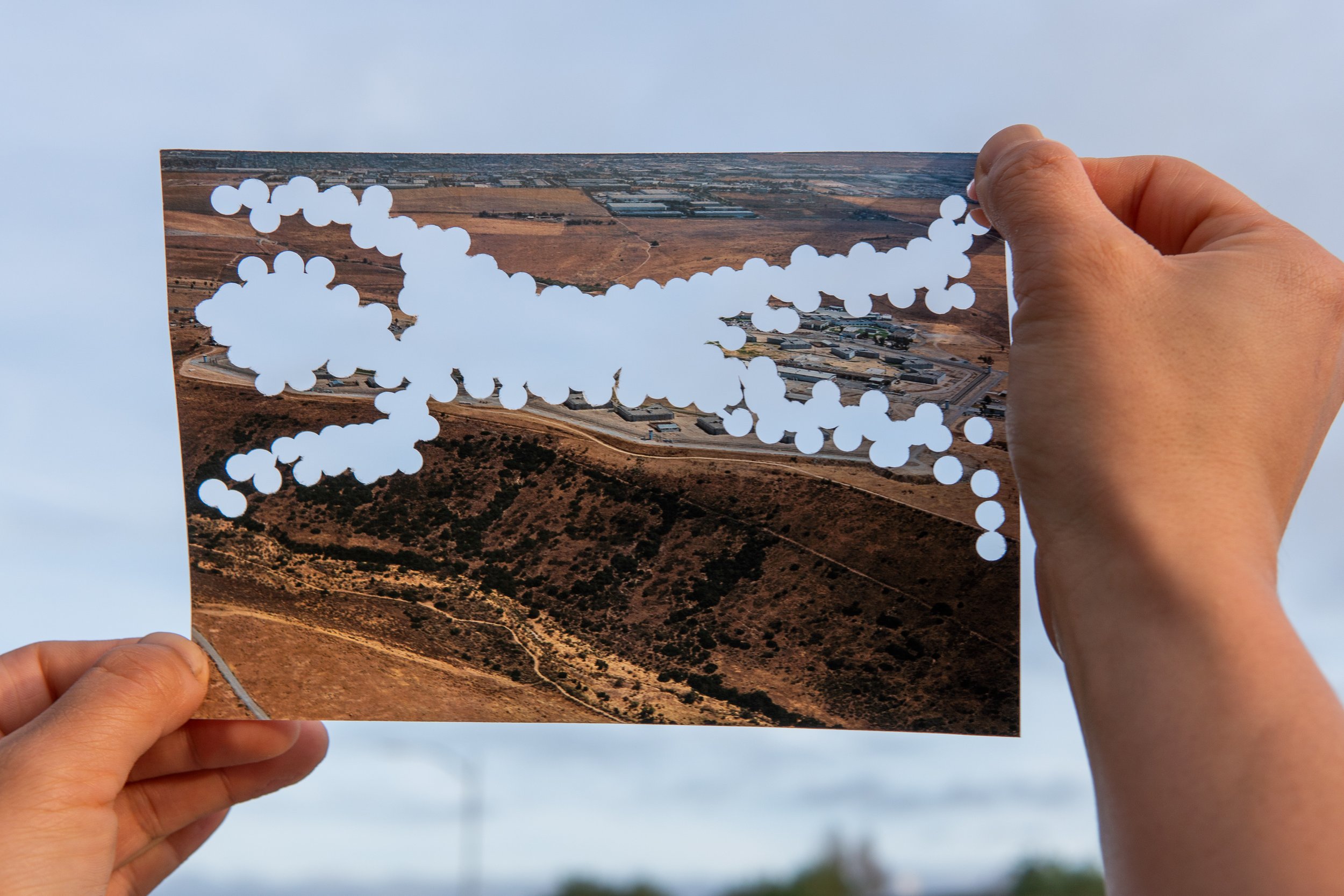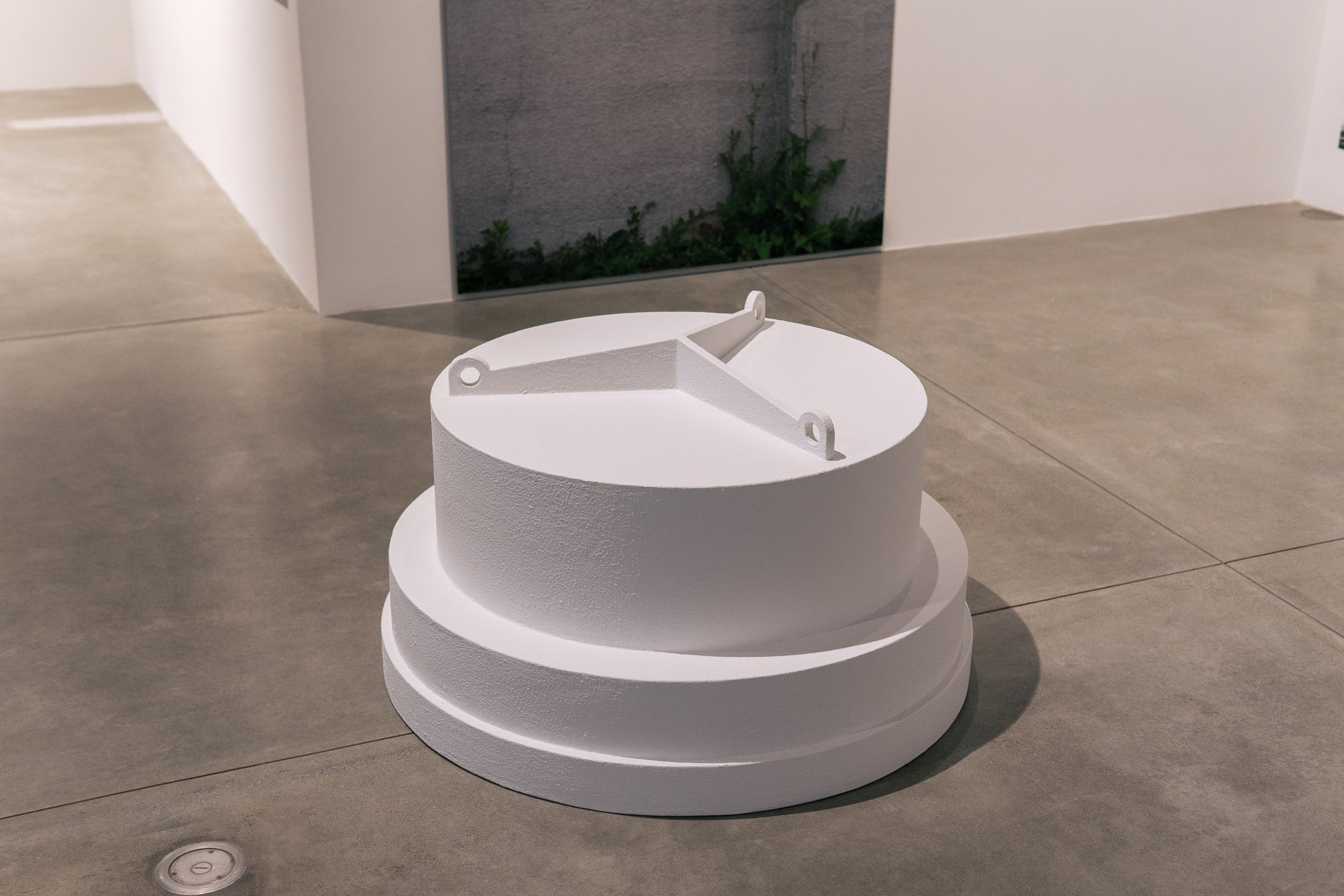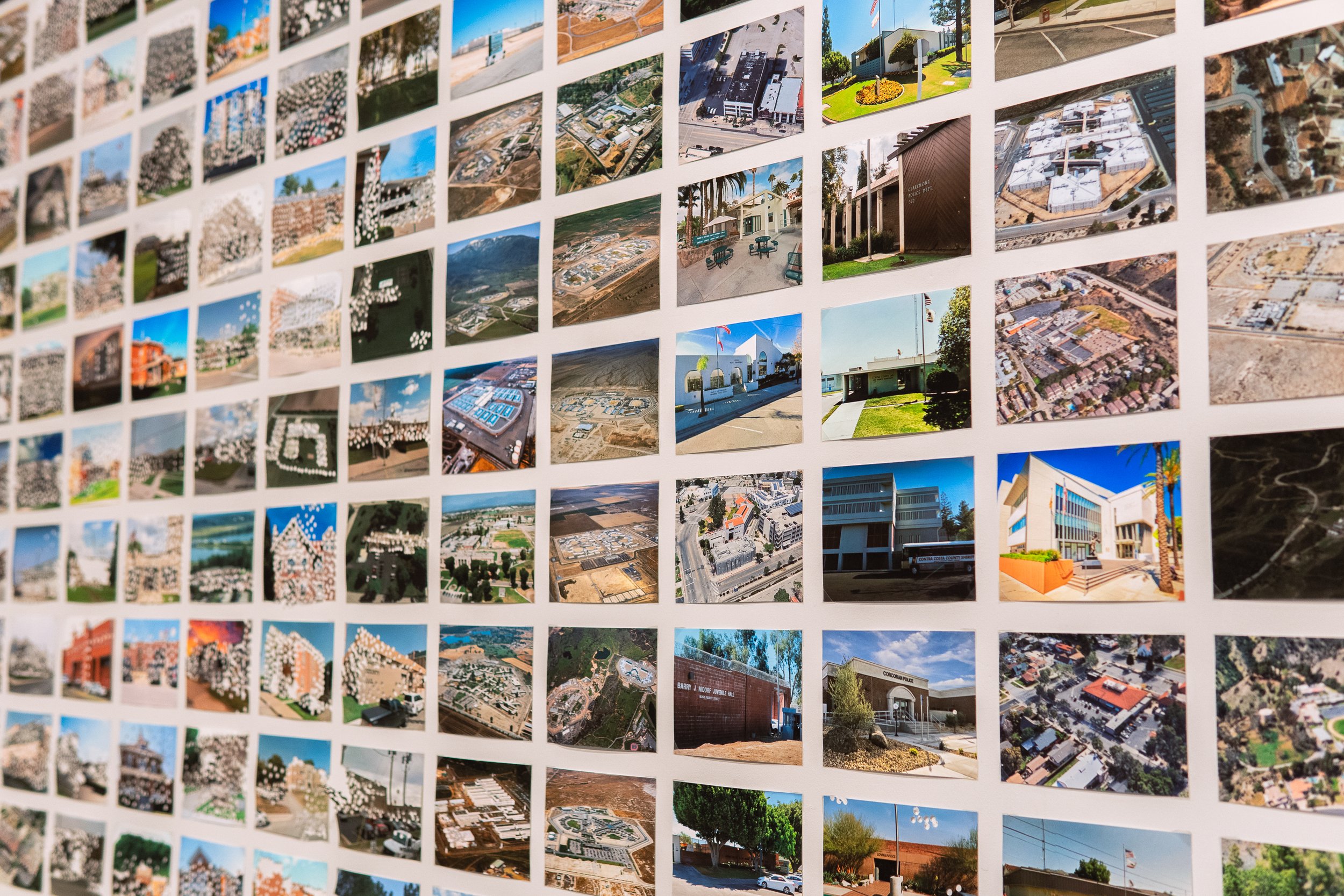Maria Gaspar’s Abolitionist Dreams Permeate ‘Compositions’
Maria Gaspar, a multidisciplinary artist, grew up in the predominantly Mexican, immigrant neighborhood of Little Village on the southwest side of Chicago, Illinois. Just blocks from her family home was Cook County Jail (CCJ), one of the United States’ largest single-site pre-detention carceral institutions. Taking up 96 acres of land, the jail is Little Village’s largest infrastructure. It is also one of the main reasons people come to Little Village—whether to visit incarcerated loved ones, access government services, appear in court, or work. Overall, residents and visitors of Little Village must confront the immense presence of CCJ at some point. It can start very early in life as it did for Gaspar. The first time she stepped foot inside CCJ was as a primary school student as part of a “scared straight” program. From that moment forward, she began thinking critically about CCJ, the purpose it serves in her community, and the larger criminal legal system.
Gaspar had the immense privilege of being raised by Carmen Gaspar, an active community member in Little Village and Chicago Public Schools for over 40 years. Carmen led two shows at a local community radio station: a Latina women’s health program and a Spanish-language poetry show in which Carmen performed using Maria’s name as her radio persona. She eventually enrolled in clown school and regularly performed at birthday parties and community events around the neighborhood. Taking Maria along with her to parties as her “mini me,” Carmen introduced her daughter to the power and beauty of creativity, performance, and, most importantly, community. “She was really good at making boring things become really beautiful,” Maria tells me.
These two components of Gaspar’s background serve as an important contextualization for her newest and first West Coast solo exhibition, Compositions, currently on view until March 2 at the University of California, Santa Cruz’s Institute of the Arts and Sciences (IAS). As part of Visualizing Abolition—an initiative supporting art, research, and programming committed to creating a world without prisons—the exhibition features new and existing works that call into question the role, consequences, and permanence of carceral institutions through painting, sculpture, video, performance, and public art.
Compositions accomplishes two important abolitionist goals. First, it rejects the inevitability of prisons and jails. Second, it emphasizes the importance of collective imagination for building a freer future.
The works in Compositions are simultaneously an interrogation and transformation of CCJ. Gaspar offers a provocation to question the historical and contemporary role that CCJ has served, the weight and permanence of that institution, and radical alternatives to our compulsive reliance on incarceration to address economic, social, and political issues.
When you first enter the exhibition, you encounter Clamour, a 60-hour time-lapse video documentation of the 2021 demolition of the oldest section of CCJ. A dedicated Gaspar set up a camera across the street from CCJ every day from 7 a.m. to 4 p.m. for about three weeks to witness the slow destruction of Division 1. Opened in 1929, Division 1 has held thousands of individuals over its lifetime, including Al Capone and John Wayne Gacy. It was even the home of the CCJ’s electric chair. Division 1 was also one of the most recognizable sections of CCJ as it towered over 26th Street, the main thoroughfare into Little Village. Important community parades and festivals, such as the Mexican Independence Day celebrations, often set up in front of Division 1. It was common for incarcerated men to engage with community members on the other side of the 25-foot wall.
In Clamour, you witness the juxtaposition of community members walking, biking, and driving by alongside the sounds of Division 1 slowly falling behind the wall. In a society where we treat incarceration as a natural and inevitable social practice, Clamour reveals the impermanence of carceral institutions and incites the viewer to explore what could exist in its place.
Positioned throughout Compositions is At the Same Time One and Many, three 1-to-1 sculptural reproductions of demolition attachments. The white bucket, claw, and magnetic grappler are no longer the steel tools seen in Clamour but artifacts that once demolished carceral institutions. The hope is that, like fossils, these artifacts will be evidence of a time when jails and prisons still existed, when prisons and jails seem as unimaginable as a Tyrannosaurus rex walking our streets today.
While recording Clamour, Gaspar noticed a pile of bricks and iron bars outside of the demolition site, possibly for workers to take as a souvenir. Gaspar began collecting items each day until a jail guard told her to stop. She ended up with 23 iron bars and bricks from Division 1. In Tumbling, she photographs these remnants almost forensically. She placed each object against a white background to emphasize the layers of paint, rust, and dirt that have accumulated over 92 years. It allows the viewer to take time to contemplate these tools of unfreedom and find their flaws, as we should with the criminal legal system. However, each object is askew to challenge the linearity that they created while being used to deny people freedom.
Gaspar refused to display the original objects—possibly to not sensationalize the violence that they inflicted or reproduce the harm on exhibition guests. Instead, Invisible Things Are Not Necessarily Not-There (after T.M.) is a transformation of these objects into glass duplications located in the center of Compositions. Gaspar sees them as “windows” into a future without prisons and jails. However, the iron bars and bricks also lose their heaviness and durability. They are now transparent and fragile.
On opposite walls is Cloud Out, a series of five paintings on large-scale, high-resolution photographs of CCJ during various stages of the demolition of Division 1. In each painting, Gaspar extends the cloudy, sun-filled sky with oils and pastels to effectively erase the jail infrastructure. What beauty and peace could this space offer to Little Village and Chicago residents if CCJ was no longer there? Cloud Out provides a different starting position to begin imagining the possibilities for our society outside of incarceration.
Gaspar doesn’t stop at just dreaming up a world without CCJ; she envisions the end of all of these oppressive institutions. Covering one wall is Disappearance Jail, an ongoing, publicly engaged archive displaying the collective erasure of jails, prisons, and detention centers. During the early stages of the COVID-19 pandemic, Gaspar began collecting and printing images of carceral institutions in Illinois. In isolation, she began using a hole puncher to perforate and remove the institution from the image. Disappearance Jail invites the general public to choose an image of a carceral institution in California printed on rice paper and creatively punch out those images with intentions for a freer future. Exhibition visitors produced many of these hole-punched images during free, public IAS workshops led by Gaspar and me in 2023 and 2024.
In an adjoining screening room, five videos document previous community-engaged, site-responsive art projects that Gaspar and her collaborators produced inside and outside of CCJ from 2012 to 2018 as part of the 96 Acres Project and Radioactive: Stories from Beyond the Wall. The projects engaged with Black and Latinx communities, incarcerated and system-impacted individuals, youth, and elders in Chicago and around the United States. These collaborative projects highlighted the knowledge, experiences, and hopes of those living in and around CCJ. They also demonstrated the power of collective creativity to build alternatives to incarceration.
On October 7, 2023, James Gordon Williams, assistant professor of music at UC Santa Cruz, performed an improvised musical piece using the original iron bars salvaged from CCJ. “We Lit the Fire and Trusted the Heat (after Angela Davis)” activated and transformed the iron bars from objects of violence to objects of freedom and possibility. He began his performance with a spiritual cleansing of the bars by spitting rum on the bars alongside John Coltrane’s “Ogunde”. The invocation of Ogun, the African deity of metalwork and war, had a direct connection to the materials of the bars but also to the Composition’s themes of abolition, transformation, and renewal. The performance challenges to the viewer to “listen differently to these materials,” as Gaspar explained in the post-performance conversation.
Prison abolition is “a political vision, a structural analysis of oppression, and a practical organizing strategy” that seeks to not only get rid of carceral institutions and the systems they depend on but also build a world “where we have everything we need: food, shelter, education, health, art, beauty, clean water, and more things that are foundational to our personal and community safety.”¹ This abolitionist future will only come into existence through collective knowledge production, strategizing, and action, because, as organizer Mariame Kaba says, “everything worthwhile is done with other people.” An abolitionist praxis requires that we work together to end our reliance on incarceration, jails, and prisons and to imagine new ways of organizing our communities. Art and artists are central to abolition in their ability to provide new perspectives on existing structures and spaces to creatively envision new possibilities. Compositions enacts an abolitionist artistic praxis by rejecting the inevitability of prisons and jails and emphasizing the importance of collective imagination for a better future.
Living within a carceral society, the necessity of jails, prisons, and detention centers largely goes unquestioned. Incarceration is often the primary assumed mode through which we can and should address various social problems, such as poverty and interpersonal violence. For example, the United States Supreme Court is currently considering whether being houseless can be criminalized as local governments seek to address the lack of affordable housing and livable wages with incarceration. Works throughout Compositions problematize the assumed stability of carceral institutions within our society. Jails and prisons will not always be with us. They do not need to have any role in how we address our problems. Just because they have existed for so long does not mean they have to continue existing. Clamour, Cloud Out, and Invisible Things each destabilize the endurance of CCJ.
Clamour documents the actual, real-life demolition of jail facilities. Viewers do not have to imagine what it looks like to get rid of a carceral institution. If it can happen to Division 1, then it can happen elsewhere. Clamour is necessary in a society where abolitionism seems like an impossibility because funding and political support for incarceration appear unending.
Building on Clamour, Cloud Out provides the viewer the opportunity to visualize the 96 acres that CCJ occupies without CCJ. Cloud Out is another provocation by Gaspar to see the CCJ as unnatural in its landscape. What can we do together in this space filled with sunshine and clouds? The space can exist apart from carcerality.
“Abolition will not come from a single, brilliant individual who will have it all figured out for the rest of us. ”
Gaspar’s act of alchemy in Invisible Things is the most powerful act of rejecting the inevitability of prisons and jails. The bricks and iron bars held thousands for over 90 years and could continue to take away freedom for another 90. As brick and iron, their opacity makes it so we cannot see what exists beyond them. They are an endpoint. As glass, we can see beyond the bricks and bars. There can be something more. As brick and iron, they are heavy and unbreakable. They are so enduring that it seems no one can destroy them. As glass, they are fragile and vulnerable. They are easy to shatter.
When abolitionists voice their desire for a freer future, they are often met with the words: “Tell us what we should do, then.” People usually say this to a single individual who they expect to conceptualize the alternative. Abolition will not come from a single, brilliant individual who will have it all figured out for the rest of us. There will be no hero to save us. Abolition praxis requires “a collective commitment to guaranteeing the survival and care of all peoples.”² Compositions is not only a challenge to carceral institutions’ existence; it offers the opportunity for us to collectively imagine freer futures. Disappearance Jail and the five videos each demonstrate the necessity of working together toward abolition.
The five videos feature examples of the possibilities that can emerge when we think, create, and dream together. For example, one 96 Acres Project video features young residents of Little Village performing a kind of “reverse graffiti” by power-washing words and phrases on the wall and sidewalks that line CCJ. Phrases like “What’s your role?” and “This is not a rehearsal” reflect how Little Village thinks about, questions, and critiques CCJ. The act of working together on this project allowed them to engage in critical dialogue and propose alternative possibilities for this space in their community. In the Radioactive video, men incarcerated at CCJ worked together as an ensemble to produce a series of animations and audio narratives that provide a complex, historical analysis of the operation of incarceration and the structural issues that push individuals into the criminal legal system. Their work was projected onto the jail wall for two nights as ensemble members who were no longer incarcerated and community members came together to share knowledge and envision a world without jails and prisons.
Fred Moten and Stefano Harney conceptualize abolition as “not so much the abolition of prisons but the abolition of a society that could have prisons, that could have slavery, that could have the wage, and therefore not abolition as the elimination of anything but abolition as the founding of a new society.”³ Art has an important role in abolitionist movements. What is the relevance of abolitionist art for Latinx communities? Police violence, gentrification, immigration enforcement, gender-based violence, educational inequities, and labor exploitation, among other violences, have marked the historical and contemporary experiences of Latinxs. The society that depends on these acts of violence for its function and order is the target of abolitionist politics. Therefore, the true liberation of Latinx communities (like all communities) relies on its abolition.
“Art, beauty, and freedom are for and constructed by all.”
For this to happen, abolitionist politics reject reformist approaches that reinforce distinctions between good/bad, deserving/undeserving, and innocent/suspect. These binaries often rely on the value systems that are at the root of Latinx communities’ oppressions. What one must do to be a good citizen, a person with a bright future, an asset to U.S. capitalism, requires assimilation into and support for systems that underlie the systemic marginalization of Latinx communities. For example, for society to consider an immigrant deserving of protection from deportation and family separation, they must prove through educational achievements, labor discipline, aspirations to serve in the military, and political silence that they are different from (more valuable than) those immigrants who are not deserving of remaining in their communities with their families. Abolitionist art encourages us to break free from dominant binaries and value systems; reclaim the full, complex humanity within each of us; and construct a space where everyone can practice new forms of being together.
Artists and their works play a central role in prompting us to ask the questions we need to ask about our current condition. In doing so, they create space for us to collectively challenge existing harmful structures and construct new visions for how we wish to organize our communities and be in better relation with one another. Only together will we create a freer, safer, and more affirming future. Compositions, reflective of Gaspar’s practice as a whole, rejects viewing our communities through a hierarchy of human value. She provides various access points through which others can engage with her work—as inspiration, as viewer, as participant, as collaborator/co-conspirator—because art, beauty, and freedom are for and constructed by all. In Compositions, Gaspar welcomes us to have abolitionist dreams alongside her.
¹ Mariame Kaba, We Do This ‘Til We Free Us: Abolitionist Organizing and Transforming Justice (Chicago, IL: Haymarket Books, 2021), pp. 2.
² Critical Resistance and INCITE!, “Statement on Gender Violence and the Prison Industrial Complex,” in Color of Violence, ed. by INCITE! (Cambridge, Mass.: South End Press, 2006), pp. 226.
³ Fred Moten and Stefano Harney, The Undercommons: Fugitive Planning and Black Study (New York: Autonomedia, 2013), pp. 24.
Michael De Anda Muñiz is an Assistant Professor in the Latina/o Studies Department at San Francisco State University. He earned his Ph.D. in Sociology from the University of Illinois at Chicago in 2020. His research and teaching focuses on art, culture, Latina/x/o communities, knowledge production, community organizing, and policing. Throughout his career, Dr. De Anda Muñiz has been committed to expanding access to art and education by teaching in prisons and jails, collaborating on public art projects, and speaking and performing in public and community spaces.











